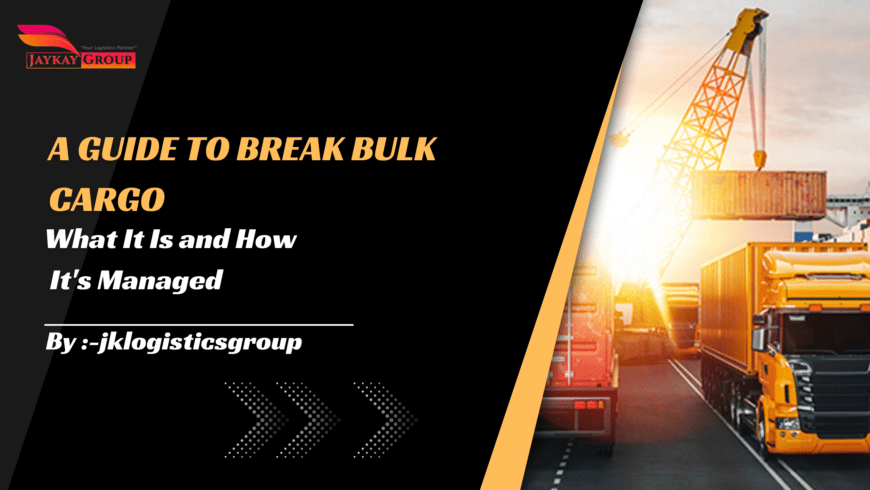What is break bulk cargo?
Break bulk cargo is referred to as when goods are transported on a ship directly rather than in containers. The term “break bulk” refers to the practice of disassembling massive shipments of products into manageable, hand-loadable parts (easily loaded and unloaded by hand).
Bags, boxes, crates, barrels, and other small pieces of cargo are examples of break bulk cargo. Cranes, forklifts, and other tools are used to carry these items onto the ship, and they are then secured to prevent damage during transportation.
Break bulk cargo is frequently used for shipments of items like machinery, vehicles, and construction materials that are too large or irregularly shaped to be transported in containers. It can also be utilized for shipments of pricey or delicate goods that need extra protection while being transported.
What is a break bulk cargo ship?
A vessel specifically built to transport break bulk cargo is referred to as a break bulk cargo ship, sometimes known as a general cargo ship. These ships frequently have cranes, hoists, and other tools that make it easier to load and unload individual cargo items, which are frequently stored in the ship’s holds or on deck.
Break bulk cargo ships come in a variety of sizes and designs, ranging from small coastal vessels to large ocean-going freighters. Some have many decks to carry various kinds of cargo, while others may be tailored to transport certain kinds of cargo, including bulk grain, timber, or automobiles.
These ships are crucial to international trade, especially when transporting items that are difficult to containerize or require specific handling. Break bulk cargo ships are still employed for a variety of cargo kinds and trade routes despite the recent growth of containerization.
Difference between bulk cargo and break bulk cargo
There are two types of cargo that are frequently transported by sea, air, or land bulk cargo and break bulk cargo. Their primary difference is how they are shipped and packed.
Commodities that are carried in large quantities but are neither packed nor containerized are referred to as bulk cargo. Bulk cargoes include things like coal, grain, ore, and petroleum. Bulk cargo is normally not broken down into smaller parts and is instead loaded directly into the ship’s hold or a specialized cargo tank.
Contrarily, break bulk cargo describes products that are packaged, containerized, and normally loaded and unloaded one piece at a time. Vehicles, machinery, steel, and timber are a few examples of break bulk freight.
What is break bulk cargo in shipping?
Break bulk cargo is defined as products that are not transported in common shipping containers but rather in discrete units or packages that are usually loaded onto a vessel using cranes, forklifts, or other specialized machinery. Machinery, lumber, steel, automobiles, and other large or heavy things are examples of this type of cargo.
Break bulk cargo usually needs more handling and warehousing than containerized cargo and is carried in smaller volumes. Longer loading and unloading delays at ports as well as increased transportation expenses may arise from this. The ability to load and unload in ports that are not containerized as well as greater flexibility in terms of the size and shape of the items being shipped are all advantages of breaking bulk cargo.
Containerization has been more popular recently because it is typically more effective and economical for bigger quantities of commodities. However, bulk cargo continues to play a significant role in the maritime sector, particularly for specialized goods that cannot be packaged in containers. Additionally, containerized shipping is not feasible in all areas and markets, thus bulk freight is still the predominant mode of transit for commodities.
Types of packaging for break bulk cargo.
Depending on the nature of the cargo being delivered and the needs of the mode of transportation, many packaging types are frequently employed for break bulk freight. Wooden boxes, barrels, drums, pallets, and bulk bags are a few of the most popular forms of packing.
Barrels and drums are frequently used for liquids or other bulk commodities, whereas wooden boxes are frequently used for large or oddly shaped items. Bulk bags are used for things like grains, powders, or chemicals, whereas pallets are used to combine smaller products into a single unit for easy handling.
For particular forms of break bulk goods, such as automobiles or machinery, specialized containers or frames may also be employed in addition to these packing styles.
How is break bulk cargo loaded and unloaded?
Usual methods for loading and unloading break bulk freight include cranes, forklifts, and conveyor systems. Break bulk cargo is often transported to the port in smaller units like wooden crates or pallets, and is subsequently loaded into the ship using cranes or other lifting machinery.
To avoid shifting or being damaged during travel, the cargo is properly packed and secured once it has been loaded onto the ship. The process of unloading is normally carried out backward, with the cargo being hoisted off the ship and delivered through trucks or other vehicles to its destination.
Break bulk freight loading and unloading can be labor- and time-intensive, especially when compared to containerized transportation.
However, it is still a crucial means of moving commodities, especially when it comes to big or massive objects that cannot be contained.
What are the advantages of using break bulk cargo shipping?
Break bulk cargo shipping is superior to other forms of transportation in a number of ways, particularly for certain products or industries. The following are some of the main advantages of break bulk cargo shipping:
- Flexibility in cargo size and type
The versatility it gives in terms of the size and type of cargo that may be transported is one of the key benefits of break bulk cargo shipping. Break bulk shipping, as opposed to containerized shipping, allows for the transportation of huge, heavy, or irregularly shaped commodities. This makes it the perfect option for sectors like construction, mining, and energy, which frequently need to carry specialized machinery or commodities.
- Access to non-containerized ports
The ability to access ports that are not equipped with the infrastructure or capacity to handle containerized cargo is another benefit of break bulk cargo shipping. In underdeveloped or isolated areas, where containerized transportation would not be a possibility, this can be very significant.
- Reduced handling and packaging costs
Break bulk cargo shipment can result in lower handling and packaging expenses for some types of commodities, even though it may involve more handling and stowage than containerized shipping. While broken bulk cargo can be transported in its current state, major machinery or equipment may need to be significantly disassembled or packaged in particular ways to fit into containers.
- Greater control over cargo
Break bulk cargo shipment gives you more control over how your cargo is handled and stored because each piece is loaded and secured separately. This might be crucial for fragile or expensive products since it lowers the possibility of loss or damage during delivery.
In general, break bulk cargo shipping offers a variety of benefits that make it a vital mode of transportation for many sectors, and is also effective.



Leave us a comment